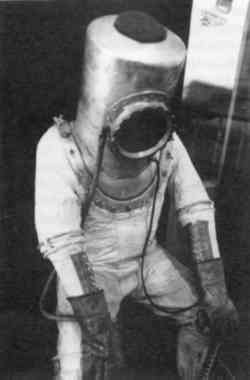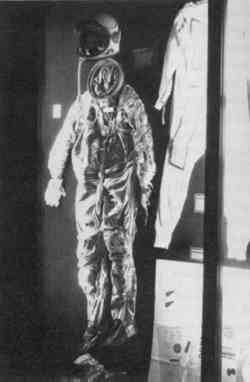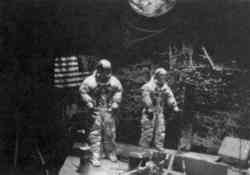HISTORY, CARE, AND HANDLING OF AMERICA'S SPACESUITS: PROBLEMS IN MODERN MATERIALSMARY T. BAKER, & ED MCMANUS
ABSTRACT—Manned spaceflight was a pivotal achievement in U.S. history, and the spacesuits used are testimony to the interdisciplinary talents and technological achievements involved in reaching this goal. Unfortunately, the materials in these suits are deteriorating rapidly, endangering our only records of some stages of the space race technology. Some materials are degrading due to poor manufacturing techniques made necessary by the push to “win the space race.” Others are deteriorating due to conditions to which they were exposed by the National Aeronautics and Space Administration (NASA) testing and use. Present methods of display and storage of these artifacts are not sufficient to delay the degradation process and, in many cases, are accelerating it. Treatment and storage decisions for these objects are not simple, as the suits contain a variety of materials, including metals, synthetic and natural textiles, synthetic and natural plastics, rubber and adhesives, as well as paints and varnishes; clearly, an interdisciplinary approach to their conservation is needed. The history of spacesuit care to date, results of preliminary testing, and some proposed storage and exhibit conditions for these materials are discussed. 1 INTRODUCTIONAir and space museums, unlike traditional museums, collect artifacts of relatively recent manufacture that are in many instances comprised of modern materials. The origins of early spacesuits can be traced to high-altitude pressurized flying suits. Suit requirements for early Mercury astronauts were similar to those for high-flying military aircraft. Suits for the Gemini, Apollo, Skylab, and Space Shuttle programs are quite different, as they had to meet different mission requirements. Advances in spacesuit design resulted from materials research and development as well as from experience gained from previous suit design. Despite significant advances in materials engineering and processing since the dawn of the space age, there is much yet to be learned, especially with regard to how such materials will age. Materials used in spacesuits and the ways in which they deteriorate are listed in table 1. Most of the deterioration processes are accelerated by high temperatures and poor temperature and humidity control. TABLE 1 MATERIALS USED IN SPACESUITS During the manufacturer's testing, certain neoprene/natural rubber blends exhibited oxidation and embrittlement. The cause was found to be impurities introduced in the processing of the blend. As time was too short to alter the process, certain stopgap measures were introduced to extend the life of the material to exceed the planned usage time. Unfortunately, the oxidation delayed by these measures has appeared over the years and is causing irreparable damage to suit parts made from the blends, including gloves, boots, and linings. Other materials pose a threat to the rest of artifact, such as plasticized polyvinyl chloride (PVC) tubing, which is a main component of the liquid coolant “underwear.” The plasticizer is migrating to the surface of the tubing and will migrate into any other plastic with which it has contact, causing possible oversoftening and deformation of that plastic. As these examples suggest, it cannot be assumed that “new objects” and “new” materials require a lesser degree of collections care than more traditional museum objects. At this time, we are possibly losing some historically significant space artifacts because of a casual approach to modern materials and objects of recent manufacture. Apollo 11 spacesuits worn during the first lunar mission in 1969 compare in historic significance to the first successful powered aircraft, the Wright Flyer. How many significant spacesuits will survive the next 90 years under existing exhibit and storage conditions? This paper addresses the history, care, and handling of America's spacesuits. It concludes with recommendations for storage and exhibit of spacesuits developed by a cooperative project between the Smithsonian Institution's Conservation Analytical Laboratory and National Air and Space Museum (NASM) and based upon preliminary materials research and past experience. 2 A HISTORY OF SPACESUIT COLLECTING AND CAREThe Smithsonian's National Air and Space Museum (NASM) owes its existence and its The early treatment of space history artifacts at the National Air and Space Museum was a simple extension of practices developed for the handling of aircraft and related artifacts. Since then, attitudes and concepts related to the historic significance of various categories of spacesuits, their use and their care, have changed considerably. During NASM's early stages, objects were collected as they became available. Deliberate collecting plans for each curatorial department were not formulated until the late 1980s. Finding storage space for new acquisitions was usually a problem; the quality of the space, provided it could be found, was of secondary concern. Some objects were damaged by strenuous handling and adverse environmental conditions. During the 1950s, the Smithsonian Institution acquired a storage site in Suitland, Maryland, and constructed several metal storage buildings with the assistance of the Department of the Navy. Procedures for handling the collections were similar to standard warehousing practice. Objects were crated or boxed in acidic cardboard boxes, often without the benefit of packing or padding material, stapled shut, and stacked on metal shelves with boxes of similar dimensions. The storage facility in Suitland has grown considerably since the 1950s. It has been named the Paul E. Garber Preservation, Restoration and Storage Facility in recognition of Garber's pioneering efforts. A new storage and restoration facility to be located at Dulles International Airport has been proposed. On March 3, 1967, by agreement between the National Aeronautics and Space Administration (NASA) and the National Air and Space Museum, the museum was given first refusal on space hardware and equipment that was retired from active service. Thereafter, spacesuits came into the collection a few at a time and at odd intervals. There was no collections policy and no preservation plans were developed for these new space age acquisitions. Many of the suits acquired by NASM were loaned to other museums and in some instances to NASA for exhibit in NASA visitor centers. A number of the suits placed on loan were sent directly from NASA to the borrowing institution or retained by NASA without registration, photography, and condition reporting at NASM. Between 1968 and 1976, as manned spaceflight programs increased, the museum acquired more spacesuits, and many of them were used as exhibit props. Backup suits and training suits were collected for spare parts. Some suits were supported with ill-fitting department store mannequins. Exhibit conditions, such as light levels, temperature, and relative humidity, were not regulated with the spacesuits in mind, and the length of time suits could be safely exhibited was not investigated. Suits were removed from exhibit when the bright white color of the outer layers of synthetic fabric turned dark yellow or became excessively dirty. In one instance, portions of a Mercury spacesuit losing the outermost aluminum coating were spray-painted silver Before 1975, spacesuits not on exhibit or loan were packed in boxes or suitcases and stored in a warehouse in Washington, D.C. In 1975, they were relocated to the Garber Facility, where they were hung on hangers and placed in tall, cedar-lined cases. At that time, there were no storage buildings with museum-quality control at the Garber Facility. Many buildings were unheated. Several factors contributed to the lack of a preservation plan for spacesuits. First, aircraft restoration was, and remains, the primary treatment activity at the National Air and Space Museum. Restoration philosophy and tradition have had a strong influence on the handling and treatment of small object collections. When a small object required treatment, it was assigned to one of the restoration specialists. The restoration process seemed to answer most collections care requirements, and for that reason, it influenced attitudes about which collections management tasks were important and which were not. It was assumed, for example, that most objects would eventually be restored. There was, therefore, less concern for storage conditions. Moreover, spacesuits, while important, were a minor element in a very large undertaking. There was great pressure to open NASM ahead of schedule. The museum staff was small, especially those whose responsibilities included collections care. Another factor that retarded the development of a preservation plan for spacesuits was the general attitude about things that are new. We take for granted objects of recent manufacture, objects we use routinely, and objects designed for rugged service. Spacesuits fit this class of objects. They are of recent manufacture and consist of seemingly indestructible modern materials such as Nomex, aluminized Kapton, and Teflon-coated silica fibers. They were designed to function in incredibly hostile environments, to keep a person alive in Lunar A final factor affecting the early care and handling of spacesuits relates to NASA's perception of its own history. It is always difficult to write the history of an event as it occurs or to identify which objects will be historically important. On one shuttle mission, for example, a satellite malfunctioned after being released from the spacecraft. The astronauts discovered that a toggle switch located on the exterior of the satellite was in the “off” position. They constructed a “flyswatter” out of spare parts on board their spacecraft, and after several attempts, swatted the switch to the “on” position. The satellite came to life, and the event demonstrated that manned missions could accomplish tasks impossible with unmanned craft. But today, the location of the “flyswatter” is unknown. Likewise, much of the data that recorded the development and testing of the early spacesuits has been discarded or lost. In some instances, the spacesuits are the last surviving remnant of that historic activity. 3 PRESENT METHODS OF DISPLAY AND STORAGEToday, all spacesuits belonging to NASM are on loan to other agencies and museums, on exhibit at the museum, or in storage (see table 2). TABLE 2 NASM SPACE SUITS ON LOAN AND IN STORAGE There are several good reasons for loaning spacesuits to other museums. One is the Smithsonian's policy of making its collections available to the largest audience possible. In addition, from 1968 until 1982, collections storage availability and conditions at NASM were marginal. Even today, museum-quality storage space for spacesuits is filled to capacity; there is, therefore, no available storage space for those suits already on loan. For many spacesuits, the loan program was, and is, very beneficial. Still, it is important that staff at borrowing institutions have proper guidance or oversight from lenders. They must be aware of the effects of light, UV radiation, and temperature. Objects should not be exposed to direct sunlight or to lights at close quarters in exhibit cases. UV filtering plexiglass should be used in case construction and installed over fluorescent light tubes. Spacesuits should not remain in the same position for extended periods of time lest uneven exposure to light cause localized damage. Light levels should be monitored, and spacesuits should not remain lit when lighting is not needed. Environmental conditions should meet the requirements for spacesuit preservation and be monitored continuously. Staff need to remember that each spacesuit was “tailor made.” The suits should not be worn by others and should be handled carefully during demonstrations. Commercial mannequins are not appropriate supports for spacesuits. Some are constructed of acidic materials and Regular condition reporting and photography are required to detect embrittlement of rubber elements and the slow gradual yellowing of a spacesuit. In the past, flaking aluminum on some Mercury spacesuits exposed the red adhesive substrate that was described by some as rust. Today the causes of such effects need to be investigated. Even spacesuits exhibited at NASM experience these problems. The extensive use of glass and skylights in the museum building exposes artifacts to high levels of ultraviolet radiation, visible light, and infrared radiation. The artifacts still have no protection from ultraviolet radiation, other than the meager filtering effect of the glass in the sky lights. During the early years, there was no collections management department or conservator, and light levels were not monitored. The museum lighting policy issued by the exhibits department established light level limits for certain categories of objects but did not specify permissible exposure times. The outer shells of the spacesuits worn by Gemini IV astronauts Ed White and James McDivitt were severely damaged by light and therefore retired to storage. Reproductions of outer garments were prepared to replace the originals. An Apollo A7LB spacesuit, which was displayed in the Skylab exhibit, was damaged by light, water from a leaky skylight, and dirt. It too, had to be removed from exhibit. The large number of visitors presents another problem. Visitor safety was and is a critical concern. Revolving entry doors used initially to conserve energy and to maintain a stable interior environment were considered a safety hazard. They were replaced with a series of doors that open directly to the outside; there is no foyer. Dirt from gravel walkways, pollution from idling sightseeing buses, and insects now have greater accessibility to the collection. Temperature and relative humidity fluctuate wildly, according to weather conditions and the number of visitors entering or leaving the building. Ironically, many important artifacts are exhibited at the major entry points: the Apollo 11 capsule containing Michael Collins' suit, John Glenn's Friendship Seven Mercury capsule, and Gemini IV with the suits of White and McDivitt. Finally, until a conservation department was established, conservation functions were shared among departments. Spacesuits placed on exhibit were not properly mounted. Environmental conditions were not monitored. Materials selected for exhibit construction did not necessarily meet conservation criteria. For example, cement dust was used to create a Lunar landscape in two exhibit cases. Among the items exhibited in the Lunar cases were Eugene Cernan's Apollo 17 Spacesuit and Apollo 11 spacesuits worn by astronauts Edwin Aldrin and Neil Armstrong. The cement dust, which was very alkaline (pH 11), had penetrated the weave of the spacesuits and was suspected of contributing to the flaking of the outer layers. For many years, this hazardous condition was not recognized. 4 RECOMMENDATIONS FOR STORAGE AND EXHIBITIONAt the present time, spacesuits that are not on loan or exhibit are stored at the Garber Facility, where a large environmentally controlled “Bally Box” (a large, walk-in refrigerator constructed by Bally Case and Cooler, Inc.) has been constructed in one of the buildings. The relative humidity is maintained at 45% and the temperature at 50�F. The parameters were established prior to any materials research and represent a While these conditions represent a vast improvement to the previous conditions, there are still problems. It is known that certain spacesuit materials become brittle with time, even at reduced temperatures and stable relative humidities. Therefore, proper support for objects and minimal handling are very important. It is also known that other materials such as polyvinyl chloride will continue to degrade and to lose plasticizer, thereby contributing to the degradation of surrounding plastics. Specific recommendations include:
5 CONCLUSIONOne of the early objectives of this cooperative project between the Conservation Analytical Laboratory and the National Air and Space Museum was to explore inexpensive and practical storage systems for space age artifacts. Resealable metal foil gas bags that could be inflated with nitrogen is one option that was considered. Initial research indicated that the degradation of certain organic materials would not cease in an oxygen-free environment. Oxygen scavengers are another alternative that might be explored. Further development of a practical spacesuit storage bag requires a better understanding of spacesuit deterioration. Companies that are presently involved in the manufacture of spacesuits have also expressed an interest in the research concerning the deterioration of historic spacesuit materials. This information may enable them to extend the functional service life of the current generation of suits. Research and experience, to date, indicate that, at the present time, historic spacesuits contain unstable materials and the best storage can only slow, not stop, their deterioration. But the greater threat is improper handling, poor exhibit conditions, and certain misconceptions about modern materials. These situations can be corrected.
REFERENCES AND OTHER SOURCESKozloski, L.Suited up for living and working in space. Unpublished typescript. Ballard, M. W., and V. L.Pledger. 1989. Mannequins: A re-examination. Abstracts of Papers Presented at the Seventeeth Annual Meeting of the American Institute for Conservation. Washington, D.C.: American Institute for Conservation. CAL. 1980. Lighting, guideline no. 195. Washington, D.C.: Conservation Analytical Laboratory. AUTHOR INFORMATIONMARY T. BAKER received her B.S. in chemistry in 1980 and her Ph.D. in 1986 in materials science with a specialty in polymer science from the Institute of Materials Science at the University of Connecticut. She has worked at the Conservation Analytical Laboratory as a research chemist since 1987, collaborating with conservators on projects such as the effects of fumigation on materials; treatment and characterization of coated papers; light bleaching of paper; and methods development for analysis of microsamples of paints, varnishes, and other materials. Her current research is on the modern polymeric materials in air and space artifacts, their aging mechanisms, storage, treatment, and display. Address: Conservation Analytical Laboratory, Smithsonian Institution, Washington, D.C. 20560. EDWARD MCMANUS is the conservator of the Smithsonian Institution's National Air and Space Museum. Prior to joining the museum, he was a conservator for the National Park Service, North Atlantic Region. He has been a member of the AIC since 1976. His early experience was with archaeological materials and metals. Mr. McManus's current interest is to foster better collections care for modern materials. Address: National Air and Space Museum, Smithsonian Institution, Washington, D.C. 20560.
 Section Index Section Index |



